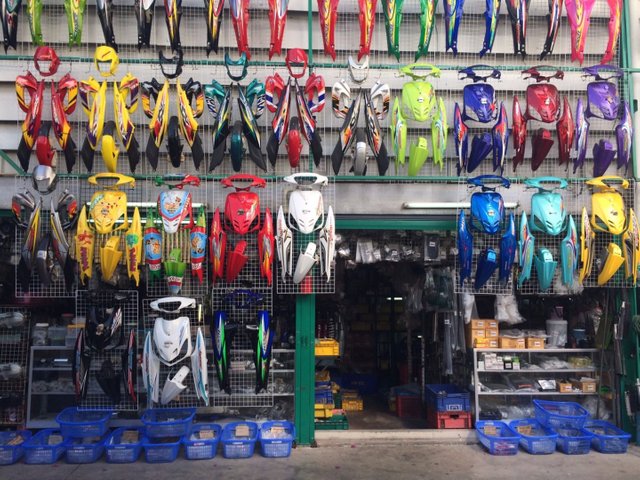Recognizing the Vital Parts of a Motorbike: A Comprehensive Guide for Fanatics
For bike fanatics looking to elevate their riding experience and ensure their bikes run efficiently, recognizing the vital parts of a motorbike is extremely important. Each element, from the engine's elaborate functions to the critical function of the stopping systems, not only affects efficiency however also safety and comfort.
Engine Elements

The camshaft plays an essential duty in managing the timing of the engine's shutoffs, making sure the accurate opening and closing necessary for reliable fuel and air intake, in addition to exhaust expulsion. This timing is vital to maintaining ideal engine efficiency and effectiveness. In addition, the carburetor or gas injection system, depending upon the motorcycle design, is in charge of blending air with gas in the appropriate proportion for burning.
The cooling system, either air or liquid-based, works to keep the engine's temperature within operational limitations, stopping getting too hot and guaranteeing long life - moto parts nz. Each element, meticulously created and incorporated, adds to the seamless operation of the engine, defining the motorbike's power output and overall efficiency
Transmission System
Indispensable to the motorcycle's performance, the transmission system makes sure reliable power transfer from the engine to the wheels. This system consists of numerous crucial elements, including the clutch, gearbox, and final drive, each playing a crucial duty in converting the engine's power right into movement. The clutch, generally operated by a hand lever, offers to disengage the engine and engage from the transmission, permitting smooth gear modifications and controlled acceleration.
The transmission, frequently described as the transmission correct, consists of a collection of gears that cyclists can by hand move via to change the bike's rate and torque outcome. These gears are organized in a sequence that allows the motorcycle to accelerate smoothly and keep optimum engine efficiency across various speeds. The majority of bikes use a sequential transmission, requiring the biker to shift equipments in an established order.
Braking Systems
While recognizing the transmission system is key to taking advantage of a bike's power, similarly crucial is the ability to regulate and quit that power effectively, which is where stopping systems come right into play. Brakes are crucial for security and performance, giving the motorcyclist with the required control to navigate different terrains and problems. Normally, motorcycles feature two kinds of braking systems: disc brakes and drum brakes.
Disc brakes are much more common in modern-day motorbikes as a result of their premium efficiency. They consist of a brake disc, caliper, and pads. When activated, the caliper presses the brake pads versus the spinning disc, converting kinetic energy into heat, thus reducing the wheel. This system provides better warmth dissipation, regular performance, and boosted quiting power, particularly in damp conditions.
Alternatively, drum brakes, though much less common, are still located in some click this link motorcycles. They work by pressing brake shoes versus the internal surface of a drum connected to the wheel. While normally much less reliable in heat dissipation and stopping power, drum brakes are less complex and a lot more cost-effective.
Comprehending these braking systems' nuances enables riders to maintain their motorcycles correctly and value the design that makes motorcycle bluetooth headphones certain effective and safe stopping.
Suspension and Guiding
Suspension and steering systems are important components that substantially influence a motorbike's handling and adventure comfort. The suspension system, including forks at the front and shock absorbers at the back, absorbs road irregularities, boosting stability and control. Front forks, upside down or normally telescopic, compress and rebound to mitigate influences, while rear shock absorbers maintain tire call with the road, crucial for grip and safety and security.
Steering, centered around the handlebars, links the cyclist to the bike's directional control. The steering head bearings make sure smooth procedure, allowing accurate maneuverability. Proper alignment and upkeep of these bearings are essential for predictable steering reaction and reducing rider tiredness.
The suspension's adjustability is one more important aspect; preload, damping, and rebound setups permit personalization to suit different riding conditions and designs. This versatility is essential for enhancing performance, whether browsing city roads or dealing with sturdy tracks. Technologies like digital suspension systems use real-time adjustments, enhancing trip high quality throughout diverse terrains.

Electrical Solutions
After making certain a regulated and smooth adventure through efficient suspension and guiding systems, interest transforms to the electric systems, an essential facet of modern motorcycles. These systems play an essential function not only in beginning the engine but additionally in powering different parts that enhance the capability and safety and security of the motorcycle.
At the heart of a bike's electrical system is the battery, which shops electrical energy needed for beginning the engine and powering complementary systems - motorbike shop. The alternator or generator, check out here combined with the rectifier-regulator, guarantees the battery continues to be charged while the motorbike functions, transforming power into electrical power and keeping voltage levels
The ignition system, one more essential part, is accountable for stiring up the air-fuel combination in the engine's cyndrical tubes. Modern motorbikes typically use a digital ignition system, offering greater performance and integrity contrasted to conventional systems.
Lighting systems, including headlights, tail lights, and indicators, are also important, making sure presence and safety for the biker. Extra digital elements such as sensors, control units, and shows add to innovative functions like fuel shot management, anti-lock stopping systems (ABDOMINAL), and electronic control panels, further enhancing the riding experience.
Conclusion
An extensive comprehension of a bike's necessary components, consisting of the engine, transmission system, braking systems, suspension, steering, and electrical systems, is vital for lovers aiming to enhance comfort, security, and efficiency. Proficiency of these aspects permits educated choices pertaining to upkeep and upgrades, ultimately boosting the riding experience. By incorporating this understanding, bikers can ensure their motorbikes run at peak efficiency and dependability, therefore taking full advantage of both pleasure and durability of their automobiles.
For motorbike enthusiasts looking to elevate their riding experience and guarantee their bikes run efficiently, understanding the crucial components of a motorcycle is paramount.Integral to the bike's performance, the transmission system makes sure reliable power transfer from the engine to the wheels.While comprehending the transmission system is essential to using a motorbike's power, just as vital is the capability to manage and stop that power successfully, which is where stopping devices come into play. Commonly, bikes include 2 kinds of braking systems: disc brakes and drum brakes.
A complete comprehension of a bike's vital parts, including the engine, transmission system, braking mechanisms, suspension, steering, and electric systems, is crucial for fanatics intending to enhance efficiency, convenience, and security.
 Luke Perry Then & Now!
Luke Perry Then & Now! Angus T. Jones Then & Now!
Angus T. Jones Then & Now! Jeremy Miller Then & Now!
Jeremy Miller Then & Now! Kenan Thompson Then & Now!
Kenan Thompson Then & Now! Jane Carrey Then & Now!
Jane Carrey Then & Now!